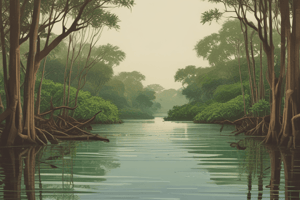Podcast
Questions and Answers
What role do intact mangroves play in protecting coastal areas from natural disasters?
What role do intact mangroves play in protecting coastal areas from natural disasters?
- Increasing the intensity of hurricanes and typhoons
- Reducing the impact of hurricanes and typhoons hitting the land (correct)
- Causing more damage to coastal communities during tropical cyclones
- Leading to more severe flooding in coastal regions
Which human activities contribute to the loss and degradation of mangroves?
Which human activities contribute to the loss and degradation of mangroves?
- Building infrastructure to protect mangrove habitats
- Draining mangrove swamps for agricultural purposes (correct)
- Establishing protected marine reserves within mangrove areas
- Monitoring diseases and controlling pests in mangrove forests
What is one of the sustainable management practices recommended to counteract mangrove loss and degradation?
What is one of the sustainable management practices recommended to counteract mangrove loss and degradation?
- Converting tidal creeks into roads and docks for easier access
- Encouraging overexploitation of mangrove timber for economic growth
- Protecting existing mangrove stands from further disturbance through legislation (correct)
- Introducing more invasive species into mangrove ecosystems
What is a community adaptation strategy mentioned in the text for communities near mangroves?
What is a community adaptation strategy mentioned in the text for communities near mangroves?
How do conservationists aim to ensure the ecological integrity of remaining mangroves?
How do conservationists aim to ensure the ecological integrity of remaining mangroves?
What is one significant economic importance of mangroves mentioned in the text?
What is one significant economic importance of mangroves mentioned in the text?
How do coastal fisheries benefit from mangroves according to the text?
How do coastal fisheries benefit from mangroves according to the text?
Which of the following is a direct consequence of mangrove loss for coastal communities?
Which of the following is a direct consequence of mangrove loss for coastal communities?
What is a potential solution discussed in the text for addressing mangrove loss and degradation?
What is a potential solution discussed in the text for addressing mangrove loss and degradation?
How does mangrove destruction negatively affect local wildlife according to the article?
How does mangrove destruction negatively affect local wildlife according to the article?
Flashcards are hidden until you start studying
Study Notes
Mangroves are highly productive ecosystems found along tropical coastlines worldwide, including areas like Lami in Fiji. These forested wetlands have significant economic importance due to their role in food production, flood protection, water purification, carbon sequestration, and habitat provision. However, they face several threats leading to various forms of loss and degradation. This has negative consequences on human populations living near these forests and also affects organisms relying on them for survival. In this article, we will examine the impacts of mangrove loss and degradation on coastal communities, discuss the main causes of such decline, explore potential solutions through sustainable management practices, look into community adaptation strategies, and finally consider how mangrove destruction can negatively affect local wildlife.
Impacts on Coastal Communities
The most immediate impact of losing mangroves is felt by the people who live nearby. For instance, coastal fisheries depend heavily upon mangroves not only for nursery grounds for juvenile fish but also because mangroves protect coral reefs from wave damage during storms. Thus, when mangroves disappear, so too do many sources of income and livelihoods for fishing communities. Additionally, erosion caused by lowland deforestation leads to saltwater intrusion affecting agriculture, contaminating wells, and increasing health risks among the population.
Moreover, mangroves play crucial roles in protecting against natural disasters such as hurricanes and typhoons. Studies show that tropical cyclones which hit land with intact mangroves cause less damage than those hitting areas where mangroves were previously present. Given that these events occur regularly in regions containing mangrove forests, it becomes clear why coastal residents stand to lose greatly if mangrove habitats continue to shrink.
Causes of Loss and Degradation
There are multiple factors responsible for the decline of mangroves around the world generally, and specifically in Lami. Natural processes such as sea level rise, sedimentation changes, and climate change can lead to mangrove loss. Humans contribute significantly too via destructive activities including overexploitation, pollution, conversion to aquaculture, shrimp farming, canalization, urban development, and industrialization. An example of unsustainable exploitation includes excessive harvesting of timber resulting in reduced resilience of mature trees, thus making them more vulnerable to disease invasion or crowding out by invasive species. Other anthropogenic reasons include draining mangrove swamps for agricultural purposes, trading logs, and turning tidal creeks into roads and docks.
Sustainable Management Practices
To counteract mangrove loss and degradation, conservationists advocate various management interventions ranging from passive restoration techniques to active restoration projects. Examples include:
- Protection of existing mangrove stands from further disturbance through legislation, zoning ordinances, buffer zones, etc.
- Replanting damaged areas either naturally using seed dispersers or artificially planting new propagules.
- Establishment of protected marine reserves within critical breeding sites for certain commercially important fish species.
- Monitoring of diseases/invasions, controlling pests, and reducing sediment runoff from adjacent lands.
These measures aim to restore—or maintain—the ecological integrity of remaining mangroves while ensuring continued benefits to humans. They require careful planning, continuous monitoring, education programs targeting local communities, and legal enforcement mechanisms.
Community Adaptation Strategies
Communities close to mangroves often need to adapt to cope with any losses. Some strategies include diversifying economically, building infrastructure to mitigate environmental hazards, promoting crop varieties that tolerate saline conditions, providing alternative income opportunities, and training locals in environmental fields to help manage resources sustainably. These approaches help reduce dependency on a single resource like mangroves, thereby improving community resilience.
Effects on Local Wildlife
Besides direct impacts on humans, there are indirect effects of mangrove loss on fauna inhabiting these areas. Many animals rely on mangroves for nesting, feeding, and sheltering. One notable case involves migratory birds that rely on mangrove habitats for resting during migration; if these habitats vanish, bird populations could suffer. Similarly, other organisms like oysters, crabs, fishes, sharks, dolphins, manatees, alligators, turtles, insects, and even mammals rely directly or indirectly on mangroves in their life cycles. As mangrove habitats decrease in size or completely disappear, the animal species dependent upon them would be affected adversely.
In conclusion, mangrove forests play vital roles globally and locally, acting both as natural barriers against natural calamities and homes for numerous types of flora and fauna. Their preservation requires concerted efforts by society and governments alike. Conservation initiatives focused on sustainable management practices combined with community adaptation strategies can ensure that both human needs and ecosystem services remain met, minimizing negative impacts from mangrove loss and degradation.
Studying That Suits You
Use AI to generate personalized quizzes and flashcards to suit your learning preferences.




